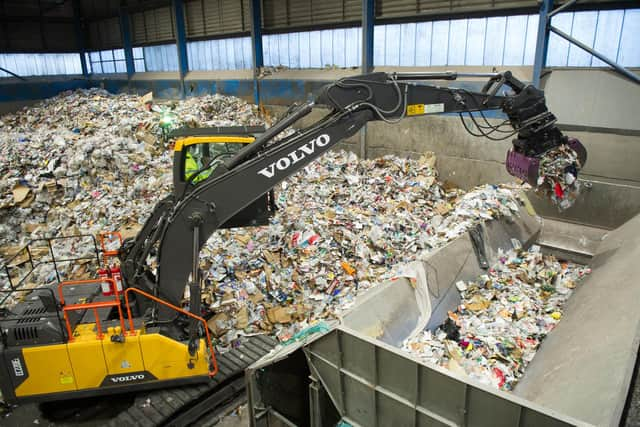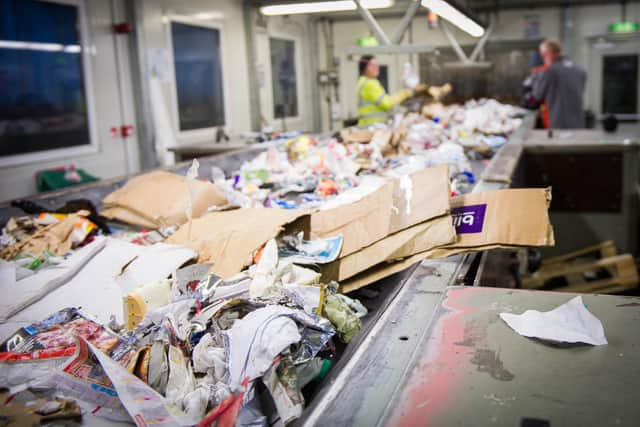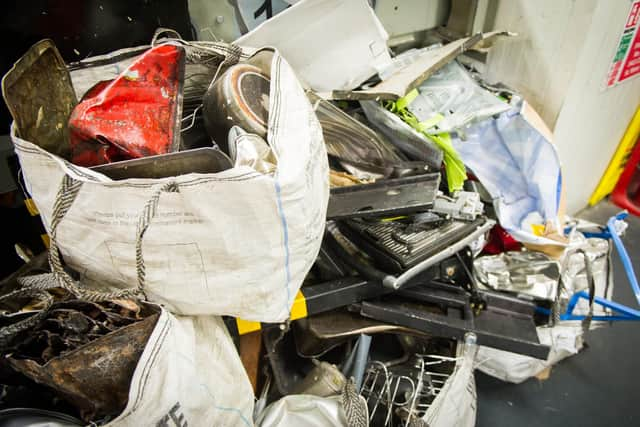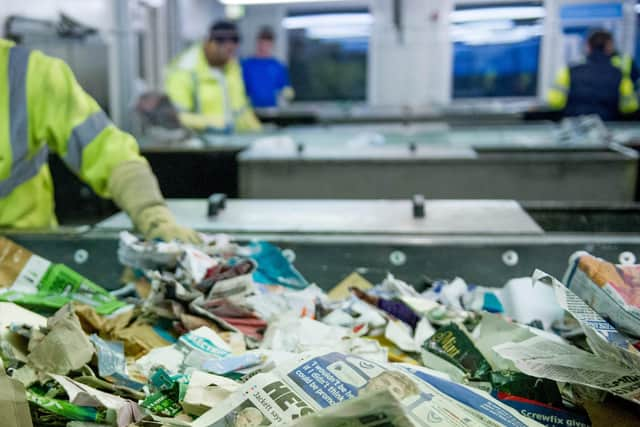Inside Portsmouth's incinerator and recycling centre - what happens to your rubbish and recycling
and live on Freeview channel 276
Turn right for recycling, and left for everything else.
It seems pretty simple - as does sorting out our own rubbish at home - but as I quickly learn from the inside of both buildings, it really isn't.
A staggering amount of waste passes through the two sites every day as they are among just five general waste and recycling plants contracted by authorities in Hampshire.


Advertisement
Hide AdAdvertisement
Hide AdSpecifically the facilities in Copnor deal with rubbish from Fareham, Gosport, East Hampshire and Winchester, and sort up to 250,000 tonnes of waste a year.
Standing outside the sites you would not necessarily know what goes on inside - there's no giveaway smell or plumes of black smoke coming from the energy recovery facility's (ERF) 65-metre chimney.
Long gone are the old fashioned incinerators of decades ago, the ERF's main purpose - as suggested by its name - is to recapture as much energy from non-recyclable waste.
And immediately next door is the materials recovery facility (MRF) where all our recyclables are sorted, which is where we visit first.


Advertisement
Hide AdAdvertisement
Hide AdAt the Portsmouth MRF around 50,000 tonnes of waste is sorted through a year - much less than the 200,000 tonnes going to the Erf. But a recent analysis of black bin bag waste in Portsmouth showed that 16 per cent of it could be recycled.
However, seeing all the waste dumped out on to the warehouse floor of the MRF it's hard to believe there could be more there. A heavy-duty digger truck is there to scoop rubbish off the floor and into an industrial funnel, which leads to a conveyor belt.
Along the belt a combination of technology and human skill separates the recyclables from the rest - and the rest could be anything from dirty nappies to video players.
Simon Larbey, the senior contract manager at Veolia, shows me around the site. ‘Unfortunately we get all sorts from dead pets - we've had two snakes, dogs and cats - to needle sticks, flares, knives and two First World War grenades,’ he says.


Advertisement
Hide AdAdvertisement
Hide AdAbout 30 people work on the belt at any one time while infrared cameras and magnets are also used to pull out materials.
In Portsmouth, and the rest of Hampshire, we can recycle plastic bottles, food tins and drink cans, aerosols, cardboard and paper at the MRF. This is all based on market need and currently a lot of plastics including yogurt pots, trays and tubs can't be sold on for recycling.
Any of these plastics that end up in the recycling will ultimately be sent to the ERF, as will cardboard contaminated with food. So you might think you're being eco-conscious when putting all your waste into the recycling but the truth is quite different.
Mr Larbey says: 'Contamination causes material to be double-handled to get the waste to the correct disposal point.


Advertisement
Hide AdAdvertisement
Hide Ad'It's very simply to avoid it, put the right materials in the right bin. We have a simple recycling mix in Hampshire: news and pamphlets, cardboard, plastic bottles, mixed paper and drinks and cans.
'Food residue and broken glass shards can prevent paper and card from being recycled.'
Greasy pizza boxes, I am told, are a prime suspect.
Once materials are separated along the belt they are shot out into piles where they are ready to be packaged into large bales.
These bales are stacked and then loaded up to be sent off to the highest bidder to be reused for something else.
It's quite a different story at the ERF.
Advertisement
Hide AdAdvertisement
Hide AdFirst the waste is tipped into an 11-metre deep bunker by a digger where an enormous 3.5-tonne grabber scoops up a pile to load into the furnace which is the other side of a wall.
When I visit the grabber is being operated manually by a worker in a control chair but it can also be set to automatic. The control room sits high above the bunker and I see a large tent and a few electrical appliances collected in one swoop of the grabber - things that should be disposed of in one of our household waste recycling centres.
The waste is then funnelled into one of the site's two furnaces. Its grate surface is kept at 300C but inside the furnace it reaches up to 1,000C. Once the incinerator is lit the flames are self-sustaining as more waste is added.
The furnaces heat up the boiler which releases steam that is fed into a steam turbine to generate electricity. In Portsmouth this process powers the ERF itself, the neighbouring MRF and around 21,000 homes.
Advertisement
Hide AdAdvertisement
Hide AdAlong the bottom of the furnace ash and metal are funnelled out. Metal is pulled out of the system by a magnet and around 100 tonnes a week goes to a scrap dealer.
And 800 tonnes of ash a week is collected and this is sold on as aggregate for road construction.
This is the shortest part of the process. Most of what the ERF has to do is cleaning what is released into the air. A number of actions are taken to do this including the injection of lime to reduce carbon and the use of high-performance filters.
Every day the output of the ERF is monitored and this information is fed directly to the Environment Agency to ensure it is within safe limits.
Advertisement
Hide AdAdvertisement
Hide AdIt's these figures, along with piles of ash and metal that are left at the end of the ERF's process.
Of course there are other ways to dispose of waste in Portsmouth as well. Other materials such as glass, textiles, cartons and batteries can be dropped off at any of the recycling banks around the city.
Similarly green-fingered residents can be a part of the garden waste scheme where their waste is then taken to one of Veolia's two composting sites - near Basingstoke and Winchester.
A current food waste trial in the city, which could become permanent in the future, is also aiming to improve recycling as it converts leftovers into reusable biogas.
Advertisement
Hide AdAdvertisement
Hide AdBut it is thought around 30 per cent of our waste is avoidable food waste and 15 per cent of what we put in our recycling bins can't actually be recycled.
So the first step for us all is to think about consumption - of both food and materials.
Mr Larbey adds: 'Ultimately it is better that people reduce their waste overall, it's better for the planet and reduces cost to local authorities.
'Waste prevention is top of the waste hierarchy.'
Why can't everything be recycled?
It's a question we ask each other time and time again - why can't we just recycle everything?
Advertisement
Hide AdAdvertisement
Hide AdThe answer is actually down to what manufacturers can recycle and what they will recycle, which depends on cost and what's in demand.
Senior contract manager at Veolia, Simon Larbey, said: ‘Veolia works with our local authority clients - who decide what is recycled locally - in order to maximise resident recycling whilst delivering value for money. As with all secondary materials, there has to be an end market and they must be “recyclable”.
‘It must be economically and environmentally sustainable to recycle something or there is no point.
‘We work closely with the UK Plastics Pact, who have made a list of what is and isn't recyclable in terms of plastics packaging and we are closely aligned to that, given that not all pots, tubs, trays are currently recyclable.
Advertisement
Hide AdAdvertisement
Hide Ad‘We do not want to get involved in collecting materials which are then exported and not recycled and we have always maintained our position on that for moral and ethical reasons.’
It is thought that 13 per cent of people in the UK don't recycle at all.
And in Portsmouth a vast amount of waste is delivered to the energy recovery facility (ERF) that could be recycled through banks across the city.
About 2,500 tonnes of glass goes into the ERF a year - this adds nothing to the energy recovery process and the process means that the glass cannot be recycled again.
Advertisement
Hide AdAdvertisement
Hide AdSimilarly 1,890 tonnes of cartons, textiles and batteries also go into the black bag rubbish - cartons and textiles can go in bring banks and batteries can be taken to supermarkets. Batteries are also a fire hazard in the ERF.
Councillor Rob Humby, environment boss at Hampshire County Council, added: ‘The collection and disposal of waste by local authorities is highly efficient but we recognise that changes are needed to help ensure less material is wasted and that we are able to capture and recycle a wider range of materials, for which there will be viable markets for recycled materials.’
Where are the current markets for our recycling: Aluminium cans - UK and Europe Cardboard/mixed paper - Europe and the far east Plastic bottles - UK Newspapers and magazines) - UK Steel cans - UK Glass - Europe
Tips for recycling
We all like to think we are making a difference every time we throw something in the green bin.
Advertisement
Hide AdAdvertisement
Hide AdThe best way to do this is to know exactly what can be recycled and what condition it needs to be in.
What we can recycle at home:
plastic bottles: this includes shampoo and conditioner bottles, spray or trigger bottles and large soda bottles. The lids can be left on but it is best for the process if the bottles are washed out and flattened if possible. cardboard and mixed paper: this must be clean - greasy pizza boxes for example are a no - as it can contaminate other waste. Paper must not be shredded as the machinery won't recognise small bits. steel and aluminium cans: these should be cleaned out with no food left in them as this leads to contamination. aerosols
What we can't recycle at home:
plastic bags, trays, tubs and pots: at the moment these can't be recycled in Hampshire so they have to go in black bag waste. glass, textiles and cartons: these can go to specific banks to then be recycled. batteries: these can be recycled at selected supermarkets.
Other top tips:
don't put recycling in boxes as the machinery needs everything separated. don't put recycling inside plastic bags for the same reason, plus the bags can't be recycled and all the contents end up going to the ERF. anything with food left inside will lead to contamination. gas canisters cannot be recycled at the MRF and also cannot be disposed of at the ERF. Take these to the household waste recycling centre along with other bulky items.
Comment Guidelines
National World encourages reader discussion on our stories. User feedback, insights and back-and-forth exchanges add a rich layer of context to reporting. Please review our Community Guidelines before commenting.